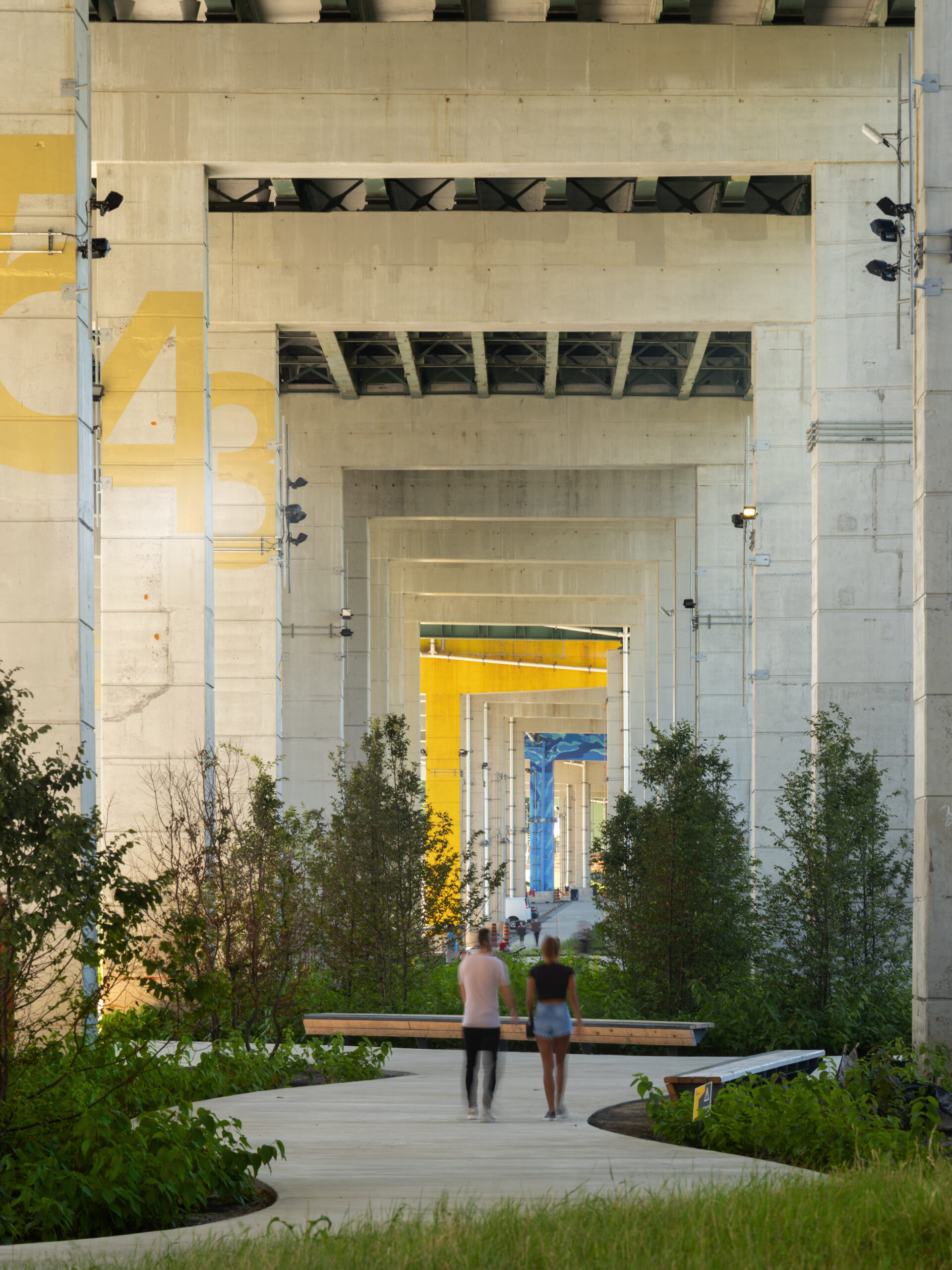Morning under the Concrete Canopy
A shaft of early light slips through the columns of the Gardiner. A few cyclists glide past sculptural benches, as if on cue to meet friends. There’s a scrunch of gravel, a faint echo of traffic overhead. This is The Bentway, operating like an urban living room beneath an expressway.
Just west of downtown, tucked between the Fort York historic site and a row of residential high-rises, The Bentway begins quietly. But its presence is felt. The architecture overhead, raw concrete, sweeping bents, weathered steel, could have been lifeless. Instead, it frames a civic stage, always half in use.
Pause here long enough and you’ll see the pulse of the city adjust itself. Office workers walking to Union. Delivery riders coasting past. People on their way somewhere pause, unexpectedly, as if to say, “Why not linger?”
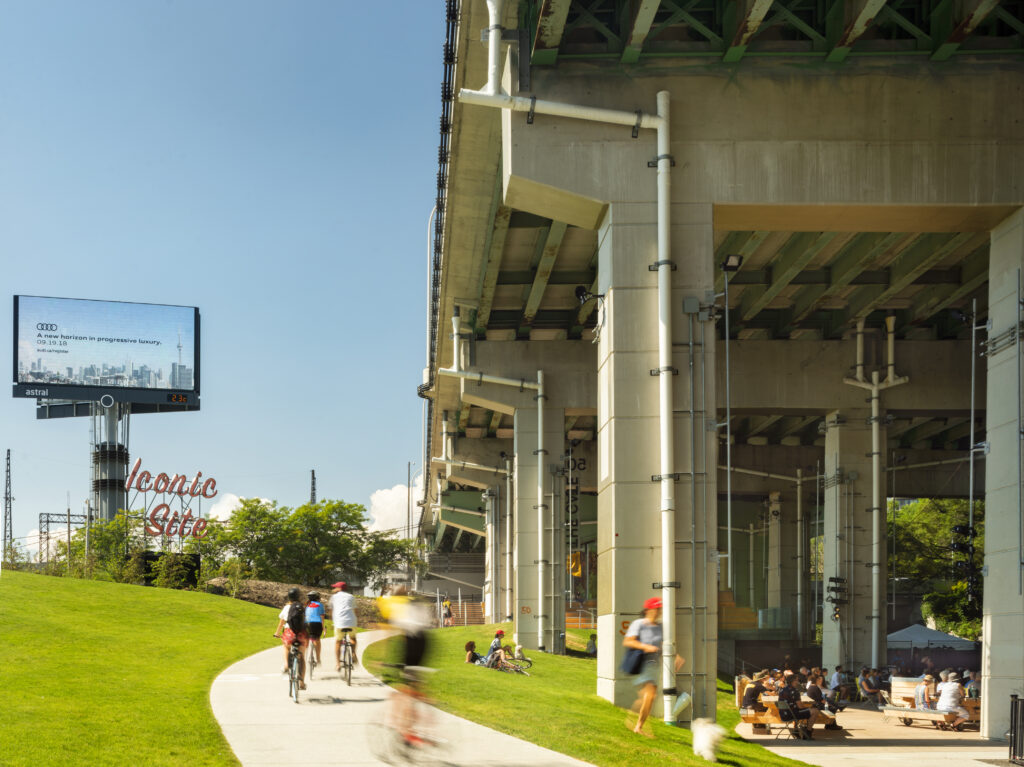
The Bentway’s Civic Landscape
What began as an underused corridor under the Gardiner Expressway has evolved into The Bentway, a linear commons and hybrid public realm. Officially launched in 2018 through a $25 million gift from Judy and Wilmot Matthews, The Bentway spans 1.75 km from Strachan Avenue to Bathurst Street. It stitches together the Fort York, CityPlace, Niagara, Liberty Village, and Harbourfront neighbourhoods, connecting 77,000 residents with shared, walkable space.
It sits partly on the Fort York National Historic Site, and its design invites continuity between past and present. The Bentway Conservancy, a registered not-for-profit and charity, works with the City of Toronto and Waterfront Toronto to activate this space as more than a path: a stage, a classroom, a garden, a forum.
In 2023, The Bentway launched its “Waterfront ReConnect” initiative, a series of artist-led interventions that reimagine the dark, disconnected spaces beneath the Gardiner. Works like Pixel Story by urbantoronto collective and Boom Town by Phoenix Pagliacci and Eklipz create new visual and emotional connections between downtown and the lake.
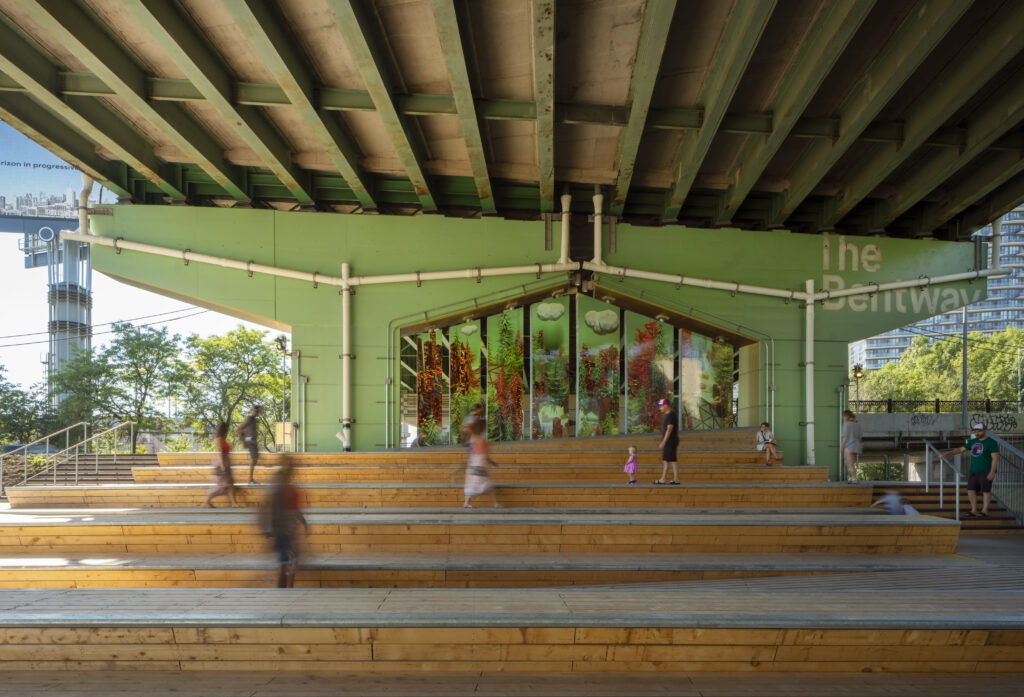
The Conservancy also engages in urban research and environmental initiatives. Through a partnership with HA/F Climate Design, it has begun studying The Bentway’s carbon impact, mapping how reused materials, planting, and program density shape its environmental footprint. These projects deepen The Bentway’s role not just as a public park, but as a site of experimentation. Part lab, part forum, part stage.
Throughout the year, The Bentway hosts a rotating lineup of free events and public programming. There are seasonal festivals, open-air concerts, pet Halloween costume parades, and surprise performances that appear almost spontaneously. Local residents often stumble across unexpected gatherings during weekend walks. One moment it might be a DJ spinning under the Gardiner. The next, a poetry reading, a pop-up dance class, or a lantern-lit procession winding through the columns. Sometimes it’s a DJ spinning under the Gardiner. Other times, it’s a poetry reading, a pop-up dance class, or a lantern-lit procession winding through the columns.
The architecture of the space itself invites reflection. Unlike traditional parks, the Gardiner overhead creates natural boundaries, an outdoor ceiling that tempers harsh sunlight and reframes the sky in narrow ribbons. Concrete columns are not obstructions, but markers. They anchor corners, host installations, and provide orientation.
The Bentway as Third Place
The Bentway’s programming is year-round and eclectic: art installations, open-air studios, roller skating lessons, poetry readings, workshops. It’s not a destination in the tourist sense, but a third place, that vital in-between space where civic life happens casually.

Unlike a library or café, The Bentway isn’t defined by walls or consumption. It’s defined by flexibility. Its “rooms” are sections beneath the Gardiner, naturally segmented by columns (“bents”) and furnished with repurposed materials, benches made from deconstructed Toronto buildings. It hosts without asking anything in return.
What’s striking is how gently it holds people. One group might be practicing tai chi while another sketches on a folding stool. A couple eats takeout beside a solo dancer warming up in sneakers. The Bentway accommodates without judgment. It feels like an agreement between strangers.
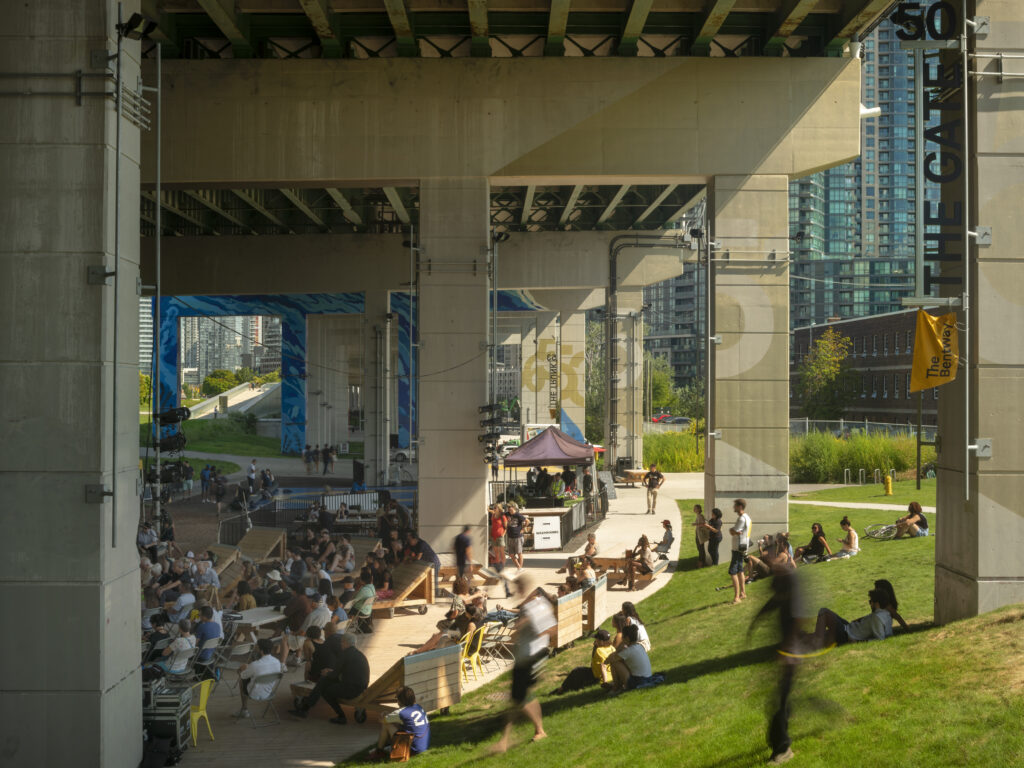
Even infrastructure feels softened. Wayfinding is minimalist, often integrated into seating or plantings. There’s a visual language of invitation, not instruction. Materials are tactile, not ornamental. Gravel paths, weathered wood, and rough steel come together to create a space where the city’s harder edges are softened by design.
Seasonal Rhythms Under the Gardiner
Summer brings rhythm. Roller skates clatter, shade sails flutter, water bottles click open. You’ll hear jazz trios warming up beside children painting on pavement. Farmers’ markets pop up beneath expressway beams. It’s informal, collective, and textured.
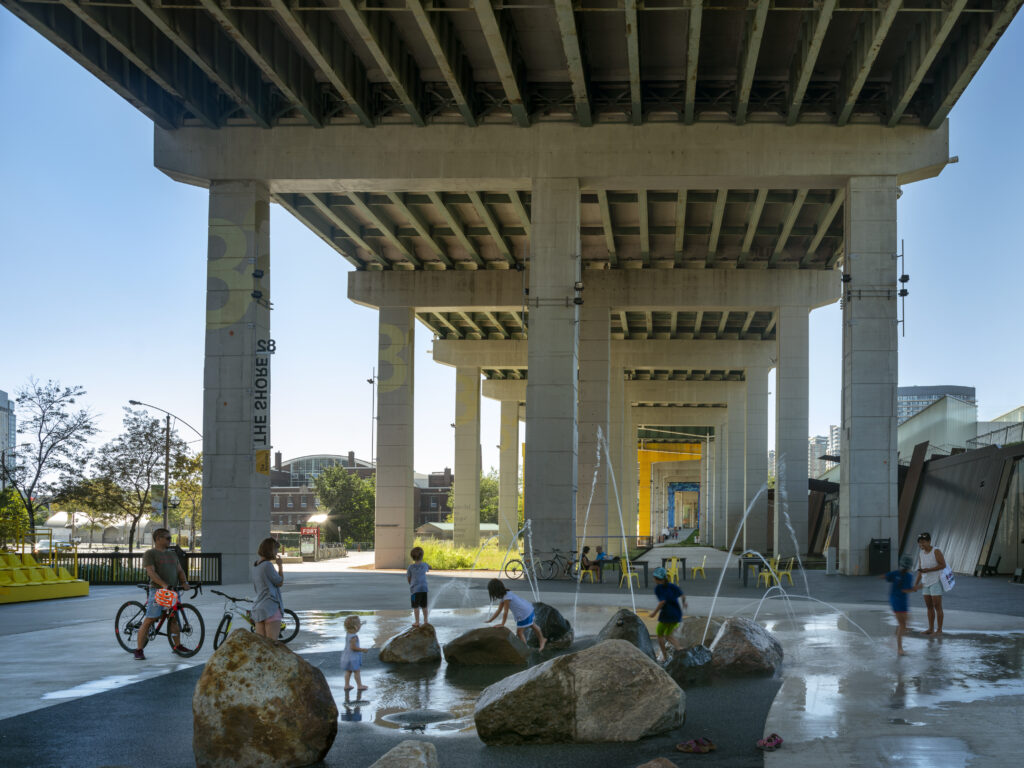
Autumn slows things down. Fallen leaves soften the gravel paths. Audio installations hum quietly between columns. It becomes a space for solo reflection, for meandering, for lingering. People bring warm drinks and sit longer. Artists use the shifting light as a frame for their work.
Winter transforms the landscape. The Bentway Skate Trail, an undulating ribbon of ice, draws thousands. In 2023 to 24, the feature installation The Gateway cast multicolour glows across skaters’ paths. Over 65,000 people visited the ice trail that season. Portable fire pits warmed hands. A shipping container served hot cider. All of it felt considered, not staged.
Even during snowfalls, the space remains gently alive. You’ll find footprints tracing improvised paths between sculptures or a kid dragging a sled past a mural. The infrastructure adapts with little ceremony. That quiet adaptability is part of its appeal.
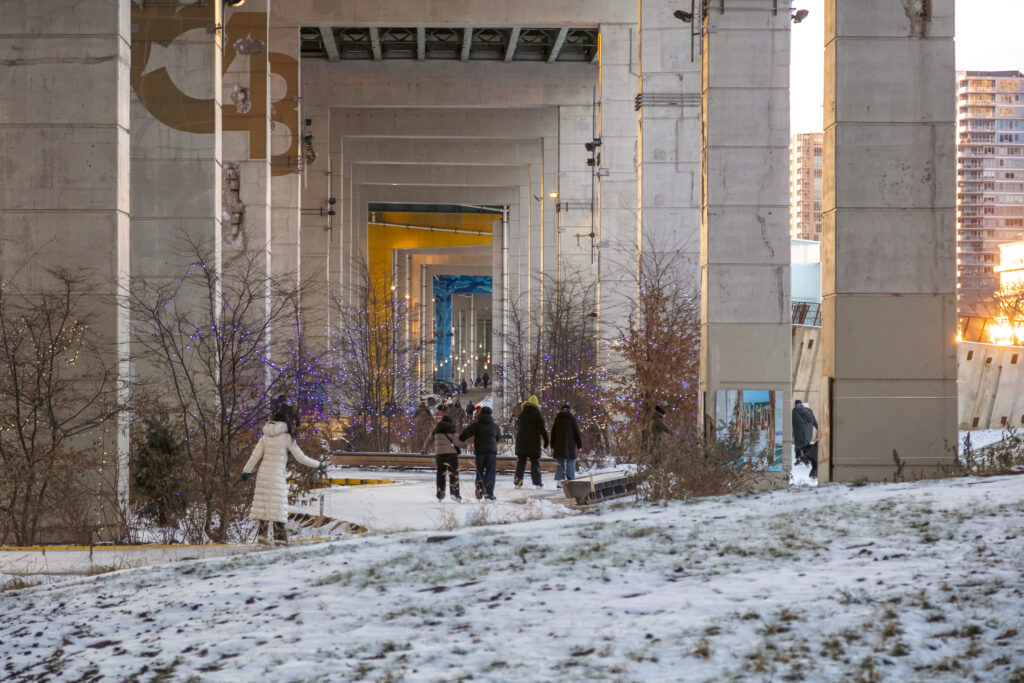
And in spring, renewal. Workshops return, benches reemerge from snowbanks, and native plantings stir from the gravel. The 2023 launch of Bentway Staging Grounds, a “living laboratory,” marked a new rhythm. This installation uses stormwater runoff from the Gardiner to irrigate a public garden beneath it. Ecology and infrastructure meet in the most Toronto of ways, quietly, beautifully, under a highway.
Why The Bentway Matters Now
In a city accelerating upward, where development often outpaces community infrastructure, The Bentway offers something rare: spatial continuity. It grounds Toronto not just in geography, but in experience.
It reflects a broader global trend of reclaiming infrastructure for civic use, as celebrated in recent features by The Guardian and Fast Company. These projects are not just about beautification. They are about reknitting communities, cooling microclimates, and providing dignified space for public life.
The Bentway joins a movement of civic transformation that includes New York’s High Line, Seoul’s Cheonggyecheon Stream, and Atlanta’s BeltLine. Yet its tone is different. It is quieter, more adaptive, less spectacle-driven. It doesn’t perform for the city so much as it holds it gently.
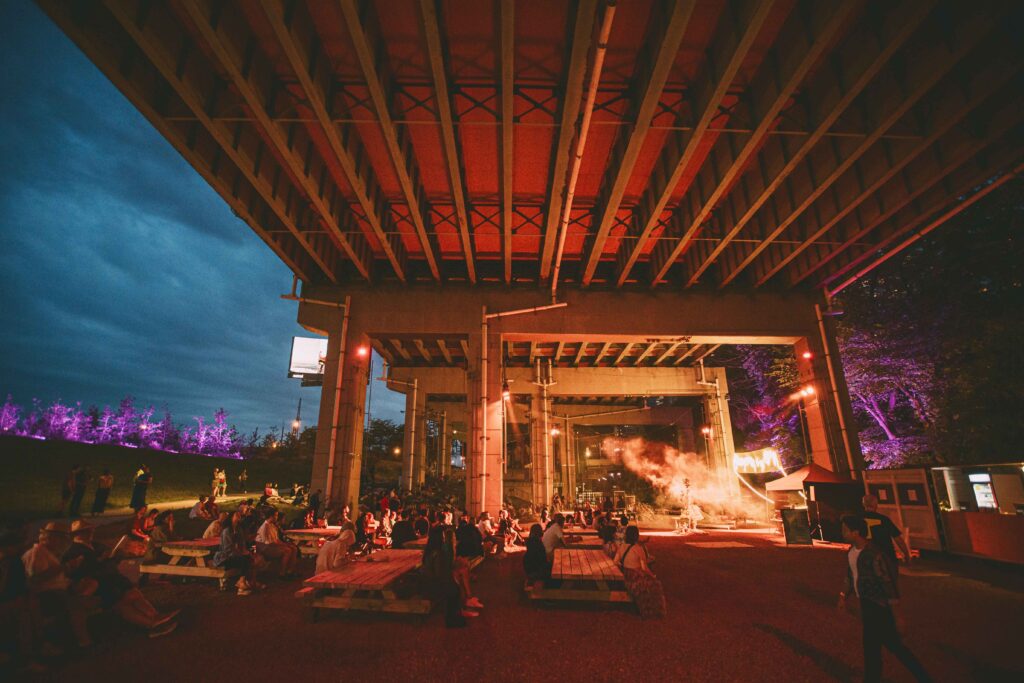
There’s also something deeply local about its palette and rhythm. It doesn’t try to disguise the Gardiner. It accepts it. Instead of hiding the infrastructure, it animates it. Concrete is not the backdrop, but the stage.
For residents seeking third places that don’t require spending or scheduling, that offer belonging without pretense, The Bentway beneath the Gardiner is a model worth watching.
The Everyday Magic of a Shared Space
To move through The Bentway is to walk through a kind of civic choreography. One that adapts to season and mood, to skaters and artists, to history and new possibility.
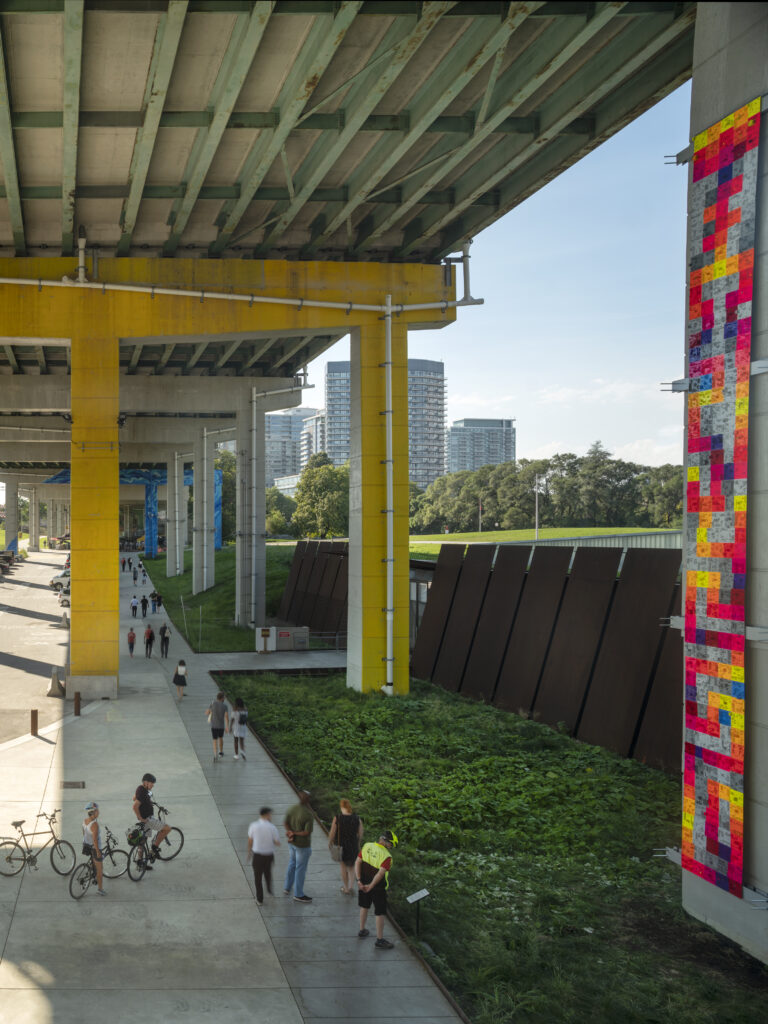
It is a place that doesn’t insist on itself. It allows presence to emerge. There’s magic in the mundane here: in the way light hits gravel, in shared glances between strangers, in the echo of a conversation that disappears beneath the highway hum.
The Bentway beneath the Gardiner doesn’t erase what came before. It builds on it, sometimes literally, and extends an invitation. Come sit, skate, stretch, or stay awhile. The city is better when it breathes together.
Discover more third places in Toronto like Stackt Market and the Ace Hotel Lobby.
